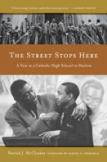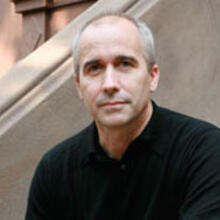A Working Model
If you are looking for a convincing argument in support of voucher programs for Catholic schools, you could do no better than Patrick J. McCloskey’s new book, The Street Stops Here: A Year at a Catholic High School in Harlem, a profile of New York City’s all-boys Rice High School. Yet as the title indicates, the power of this work is not so much in its policy analysis—though McCloskey skillfully lays out the issues—but in the frank and moving narrative he unspools over the course of 400 richly detailed pages.
In the end, that narrative makes the case for Catholic schools, but does so almost obliquely, and because of that perhaps more convincingly than the usual efforts. As the journalist and author Samuel G. Freedman writes in the foreword, this book is not “an advertising brochure” for Catholic schools, even though McCloskey is clearly a fan. Instead, as Freedman writes, “By admitting to imperfection…this book makes the most persuasive case possible for what Catholic education has achieved and how its example can help improve public education.”
McCloskey does this by sticking to the story, or rather stories. The book is an omnibus of sorts, which as the author admits is part of the “unavoidable structural complexity” of writing about such a variegated community. Yet McCloskey is a diligent craftsman and that makes the book work, and makes The Street Stops Here a standout in the welter of educational wonkery.
The central characters of the story are the African-American principal, “a charismatic and complex visionary” named Orlando R. Gober, and the Irish-American president of Rice, Brother J. Matthew Walderman, a member of the Congregation of the Christian Brothers that founded the school in central Harlem in 1938. As with most schools run by religious orders, the role of lay people has expanded as the presence of priests and religious has diminished sharply. That transition is not without tensions, and the fraught relationship between the tall, athletic and impulsive Gober and the bald, thick-set Brother Walderman is told with unflinching honesty. “They get along by avoiding each other as much as possible,” McCloskey writes early on. That Walderman granted McCloskey such uncensored access is a rare thing, and yet the portrayal here rewards that magnanimity.
Race is another central tension, one that is in many respects unique to inner-city Catholic schools like Rice, but one that can perhaps be more instructive for Catholics than traditionally homogeneous settings. Readers will (or should) cringe at times as racial issues are laid bare, and the stories of the students who pass through Rice are not always feel-good, made-for-TV-movie fare. McCloskey also deals with the complex questions plaguing education in America, especially in poor urban areas: academics versus athletics, communicating religious values versus indoctrination, and balancing tough love with an understanding of the even tougher life that awaits the students when they leave school.
So what can this book tell us about the future of Catholic schools? Can they be saved? That is the question everyone in the church is asking today, and the one McCloskey set out to answer.
Born in Canada and educated in Catholic schools in Ottawa—which receive state funding with little fanfare—McCloskey was drawn to his subject by the furor over school vouchers in the United States. He also writes from the perspective of a father trying to find good schools for his own children, rejecting first a soulless public system in upscale New Jersey suburbs, then the mediocrity of public schooling in New York City, and finally settling on a private school in Brooklyn that provided a superb education but at a cost that entailed serious financial sacrifices.
Propelled by a desire to find out what works in education, and what could be improved and made affordable, he decided to make a “qualitative” study of a single school to see what lessons he could learn and then impart. The Street Stops Here is the result.
The book impressed me. As an adult convert to the church, I missed out on the classic parochial school experience—uniforms, Latin declensions, nuns both stern and encouraging and, above all, the chance to transform my miserable grade school years into a comedy routine or memoir of lament. Darn. But that lacuna has also left me, regrettably, with a certain indifference to the plight of Catholic education. I am not against Catholic schools by any stretch; rather, my parish life experience is one of churches and dioceses that struggle so mightily to keep their schools alive that they too often—or so it seems to me—sacrifice outreach programs for young adults and families who could encourage more youngsters to attend those schools.
McCloskey does not necessarily dispel all my biases, but he does something more profound: he forces me to face up to the challenge as well as the promise of Catholic education. There is much talk about shoring up “Catholic identity” these days, yet often lost in that navel-gazing is the axiom popular among Catholic educators who are forming young people with little or no connection to the church: “We’re here because we are Catholic,” they say, “not because they are.”
To be sure, Catholic schools and parents everywhere are getting squeezed by rising costs. But the decline in Catholic education is most poignant for urban areas where children, often African-Americans, desperately need good alternatives, and for Latino immigrants who cannot find the good and affordable Catholic education that previous generations enjoyed. Some four in 10 Catholic schools are still located in inner cities, but the trend is to close those and shift Catholic education to the suburbs where there are more Catholics who can afford a Catholic education.
It is a painful transition with no easy answers, if there is an answer at all. In that sense McCloskey’s book illustrates what Catholic schools can be and pays tribute to what the Catholic Church in America may never again achieve.
This article also appeared in print, under the headline “A Working Model,” in the August 17, 2009, issue.








